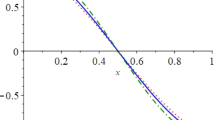Abstract
In the past few years, efficient methods have been developed for bounding probabilitiesand expectations concerning univariate and multivariate random variables based on theknowledge of some of their moments. Closed form as well as algorithmic lower and upperbounds of this type are now available. The lower and upper bounds are frequently closeenough even if the number of utilized moments is relatively small. This paper shows howthe probability bounds can be incorporated in probabilistic constrained stochastic programmingmodels in order to obtain approximate solutions for them in a relatively simple way.
Similar content being viewed by others
References
E.M.L. Beale, On minimizing a convex function subject to linear inequalities, Journal of the Royal Statistical Society B47(1955)173–184.
C.E. Bonferroni, Teoria Statistica Delle Classi e Calcolo Delle Probabilità, Volume in onor di Riccardo Dalla Volta, Università di Firenze, 1937, pp. 1–62.
G. Boole, Laws of Thought (American reprint of 1854 edition), Dover, New York, 1954.
E. Boros and A. Prékopa, Closed form two-sided bounds for probabilities that exactly r and at least r out of n events occur, Mathematics of Operations Research 14(1989)317–342.
A. Charnes, W.W. Cooper and G.H. Symonds, Cost horizons and certainty equivalents: An approach to stochastic programming of heating oil, Management Science 4(1958)235–263.
G.B. Dantzig, Linear programming under uncertainty, Management Science 1(1955)197–206.
D. Dawson and A. Sankoff, An inequality for probabilities, Proceedings of the American Mathematical Society 18(1967)504–507.
Th. Hailperin, Best possible inequalities for the probability of a logical function of events, The American Mathematical Monthly 72(1965)343–359.
P. Hansen, B. Jaumard and G.-B.D. Nguesté, Best second order bounds for two-terminal network reliability with dependent edge failures, Discrete Applied Mathematics, to appear.
D. Hunter, Bounds for the probability of a union, Journal of Applied Probability 13(1976)597–603.
S.M. Kwerel, Most stringent bounds on aggregated probabilities of partially specified dependent probability systems, Journal of the American Statistical Association 70(1975)472–448.
L.B. Miller and H. Wagner, Chance-constrained programming with joint constraints, Operations Research 13(1965)930–945.
T. Popoviciu, Les fonctions convexes, in: Actualités Scientifiques et Industrielles 992, Hermann, Paris, 1945.
A. Prékopa, On probabilistic constrained programming, Proceedings of the Princeton Symposium on Mathematical Programming, Princeton University Press, 1970, pp. 113–138.
A. Prékopa, Contributions to the theory of stochastic programming, Mathematical Programming 4(1973)202–221.
A. Prékopa, Boole-Bonferroni inequalities and linear programming, Operations Research 36 (1988)145–162.
A. Prékopa, Sharp bounds on probabilities using linear programming, Operations Research 38 (1990)227–239.
A. Prékopa, The discrete moment problem and linear programming, Discrete Applied Mathematics 27(1990)235–254.
A. Prékopa, Inequalities on expectations based on the knowledge of multivariate moments, in: Stochastic Inequalities, eds. M. Shaked and Y.L. Tong, Institute of Mathematical Statistics, Lecture Notes — Monograph Series 22(1992)309–331.
A. Prékopa, Stochastic Programming, Kluwer Scientific, 1995.
A. Prékopa, Bounds on probabilities and expectations using multivariate moments of discrete distributions, Studia Sci. Math. Hungar. 34(1998)349–380.
A. Prékopa, On the concavity of multivariate probability distributions, RUTCOR Research Report, 1998, to appear.
O. Ruff-Fiedler, A. Prékopa and C.I. Fábián, On a dual method for a specially structured linear programming problem, Mathematical Methods of Operations Research (1998), to appear.
T. Szántai, A computer code for solution of probabilistic constrained stochastic programming problems, in: Numerical Techniques for Stochastic Optimization, eds. Yu. Ermoliev and R.J-B Wets, Springer, New York, 1988, pp. 229–235.
R.J-B Wets, Programming under uncertainty: The complete problem, Zeitschrift für Wahrsch. 4 (1966)316–339.
Rights and permissions
About this article
Cite this article
Prékopa, A. The use of discrete moment bounds in probabilisticconstrained stochastic programming models. Annals of Operations Research 85, 21–38 (1999). https://doi.org/10.1023/A:1018921811281
Issue Date:
DOI: https://doi.org/10.1023/A:1018921811281




